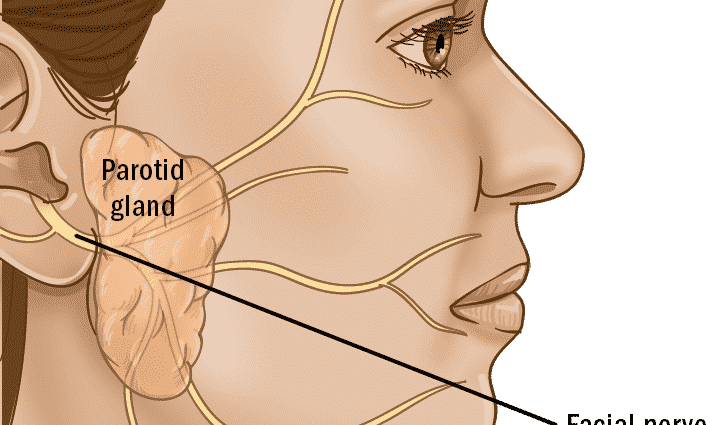Contents
Parotidectomy
Parotidectomy is a surgical procedure consisting in the partial or total removal of the parotid gland, a small salivary gland located in front of and under the earlobe. This gland can be the site of infection, inflammation, benign or malignant tumors.
What is parotidectomy?
Parotidectomy refers to the partial or total removal of the parotid gland (para for “beside”, oris “ear”), a gland located in front of the ears and behind the mandible. Weighing around 25g, this gland is the largest of the salivary glands. Inside passes the facial nerve, which makes it possible to contract the muscles of the face.
Comment if the parotidectomy passes?
The operation takes place under general anesthesia.
The surgeon begins by making an incision just in front of the ear and then under the lobe, over a few centimeters at the neck. He locates and dissects the facial nerve and then removes the tumor and surrounding glandular tissue. The operative part is sent directly for histological analysis during the operation (so-called “intraoperative” histological examination). Depending on the nature of the tumor, the parotidectomy will be:
- partial in case of benign tumor;
- almost total in case of mixed tumor to avoid recurrence;
- total and supplemented by treatment of the ganglionic chains of the neck in the event of a malignant tumor.
The facial nerve is preserved, unless, for example, the tumor is stuck to the nerve.
The skin is then sutured and a drainage system is put in place.
When to perform a parotidectomy?
Different pathologies can affect the parotid gland. Here are the main ones:
- sialitis, i.e. inflammation of the gland, of viral or microbial origin;
- sialosis, or enlargement of the gland of non-infectious origin;
- a benign tumor (pleomorphic adenoma, monomorphic adenoma, Warthin’s tumor);
- a cancerous tumor (malignant epithelial tumor, mucoepidermoid carcinoma, acinar cell carcinoma, adenocarcinoma, adenoid cystic carcinoma, etc.);
- a true tumor, generally benign, of nervous origin (neuroma of the facial nerve, neurofibromas), vascular (hemangioma or cystic lymphangioma of the child), fatty (intra parotid lipoma).
Cancerous tumors of the parotid gland are treated with parotidectomy, usually followed by radiation therapy. But benign tumors must also be operated on because there is on the one hand a risk of progression to a malignant tumor, on the one hand for certain tumors, only the histological examination of the surgical excision part makes it possible to define the nature of the swelling. Finally, some tumors can become infected or increase in size, making the procedure much more dangerous to preserve the facial nerve.
After parotidectomy
Operative suites
The pains are moderate and pass with analgesic treatment. Slight edema is normal.
In the risk of infection, antibiotic treatment may be prescribed.
The hospitalization lasts from 3 to 5 days, the sick leave of 2 weeks on average.
The risks
Rare complications can occur after or after the operation:
- bleeding or bruising that may require reoperation;
- decreased mobility or paralysis of facial muscles, partial or total. This phenomenon is generally transient, but physiotherapy is sometimes necessary to regain full mobility;
- decrease or loss of earlobe sensitivity, which most often resolves spontaneously within a few months;
- Frey’s syndrome, characterized by the appearance, in the operated area, of redness and sweat during feeding. Linked to a disorder of the nerves of the skin, this syndrome is generally not definitive;
- definitive facial paralysis is exceptional.
The removal of the parotid gland does not affect the secretion of saliva because the other salivary glands (submandibular and sublingual) will compensate.











Подходящи храни след такава операция?